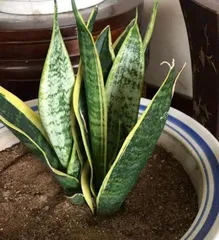Snake Plant is a common indoor green plant, beloved for its beautiful leaves and easy-to-care-for nature. However, to make the Snake Plant grow strong and sturdy leaves, we need to provide proper care and pay attention to some tips. This article will introduce you to the correct way to care for a Snake Plant, helping you create a lush green plant paradise with robust leaves.

I. Provide Ample Sunlight
To help the Snake Plant grow strong and sturdy leaves, we need to provide it with ample sunlight. Sunlight is a vital source of energy for photosynthesis, which promotes the growth and development of leaves. Place the Snake Plant in a bright location where it can receive at least 6 hours of sunlight daily.
II. Water Properly
Snake Plants have moderate water needs; too much or too little water can adversely affect leaf growth. When watering, you can touch the soil surface with your finger and only water when the soil feels dry. Do not let the Snake Plant remain in overly moist conditions for extended periods to prevent root rot.

III. Control Temperature Appropriately
The ideal temperature range for Snake Plant growth is 20°C to 25°C. Temperatures that are too high or too low will negatively impact leaf growth. In the summer, you can place the Snake Plant in a well-ventilated area to maintain a suitable indoor temperature. In the winter, it's important to keep it warm and avoid exposing it to cold climates.
IV. Balanced Fertilization
Snake Plants have low nutritional requirements; generally, fertilizing once a month is sufficient. Choose a fertilizer rich in nutrients such as nitrogen, phosphorus, and potassium, and follow the instructions on the packaging. Remember not to over-fertilize, as this can harm the Snake Plant.
V. Regular Pruning
Regularly pruning the leaves of a Snake Plant can encourage thicker, more robust growth. When the leaves become too long or too dense, you can use sharp scissors to trim away the excess parts. Be hygienic during pruning to avoid spreading diseases.

VI. Provide Suitable Humidity
Snake Plants prefer a humid environment but also need adequate ventilation. You can increase indoor humidity by placing a water tray or a humidifier near the plant, but be careful not to over-humidify to prevent the growth of diseases.
VII. Promptly Deal with Pests and Diseases
Snake Plants are susceptible to common pests and diseases such as aphids and powdery mildew. Once you notice any pest or disease issues, take timely treatment measures. You can use specific pesticides or biological control methods to maintain the healthy growth of the Snake Plant.
VIII. Use Suitable Potting Soil
Choosing the right potting soil has a significant impact on the leaf growth of a Snake Plant. Generally, you can choose a potting soil that is well-aerated and has good drainage. You can mix in materials like sand or leaf mold to create a suitable soil mix according to the plant's preferences.
IX. Keep Leaves Clean
Dust and debris can accumulate on the leaves of a Snake Plant, affecting its normal photosynthesis. Regularly wipe the leaves gently with warm water to keep them clean and smooth. You can also use a leaf shine spray for plants to make the leaves more vibrant.
X. Repot and Refresh Soil Appropriately
A Snake Plant needs to be repotted and have its soil refreshed once a year. Remove the plant from its old pot, remove the old soil, and trim the roots. Then, transplant the Snake Plant into a new pot with fresh potting soil to give it a better growing environment.
XI. Prevent Excessive Sun Exposure
Although Snake Plants need sunlight, excessive exposure to strong sunlight can damage their leaves. During hot summers, you can place the Snake Plant under a shade net or a sheer curtain to protect it from intense sun.
XII. Loosen Soil Regularly
Snake Plants prefer loose soil. To maintain soil aeration and drainage, you can loosen the soil regularly. Gently turn the soil with a small trowel to promote root growth and increase soil fertility.
XIII. Control Fertilizer Amount
Fertilization is key to the growth of a Snake Plant, but over-fertilization can negatively affect leaf growth. Adjust the amount of fertilizer based on the plant's growth and needs to avoid excessive application.
XIV. Avoid Excessive Handling
While the Snake Plant is relatively easy to care for, excessive handling can negatively impact its leaf growth. Avoid frequently moving, rotating, or touching the plant to prevent interference with its normal growth and development.
XV.
With proper care techniques and some helpful tips, we can easily grow Snake Plants with strong, sturdy leaves. Providing ample sunlight, proper watering, and appropriate temperature control are all key. Additionally, regular pruning, keeping the leaves clean, and promptly addressing pests and diseases are important measures to maintain the health of the Snake Plant. We hope this guide will help you better care for your Snake Plant and create a lush green plant paradise.